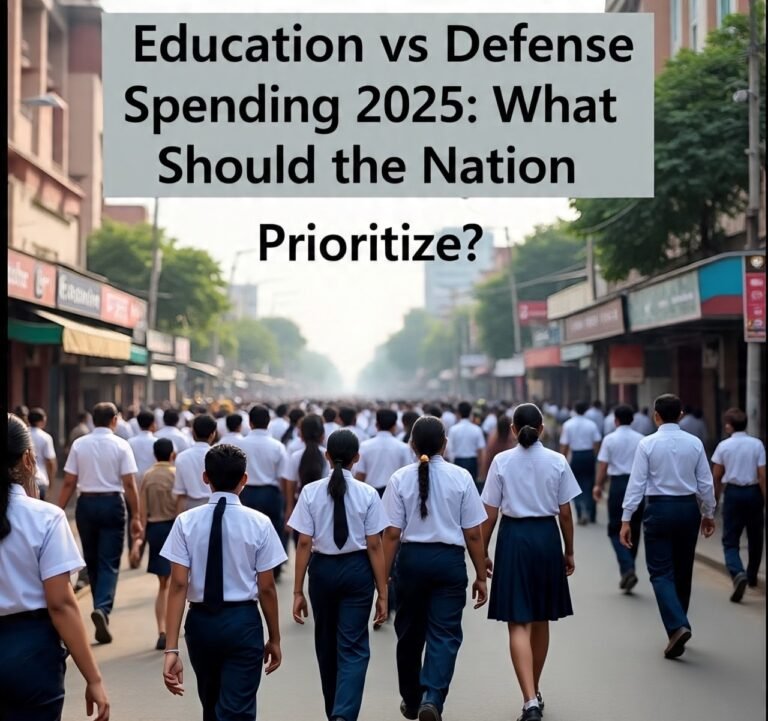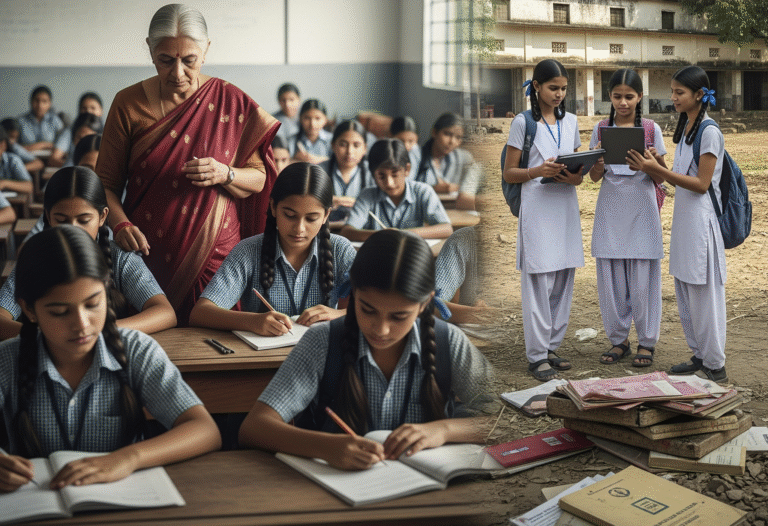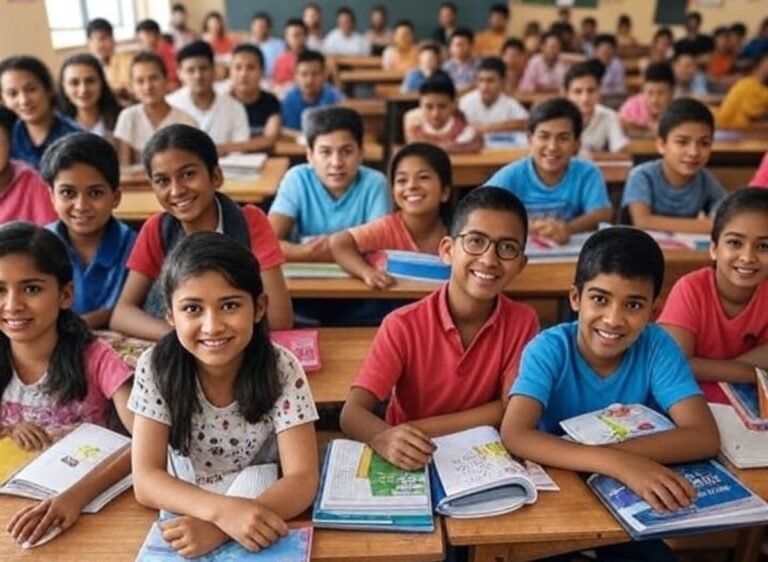Free Education: A Necessity for India’s Future

India, a land of dreams, 1.4 billion people, young nation, 600 million under 25. Education’s the key to progress, to power, but costs block the way. Fees, books, uniforms — too high. Many drop out, 32% before high school.
Free education, a bold idea, a must for India’s future. Why free education? How to do it? What’s at stake? Here’s the full story.
Why Free Education?
Education lifts lives, builds nations. India knows this, yet it stumbles. Costs hit hard. A rural family earns ₹1-2 lakh yearly. School fees? ₹10,000-20,000. Private schools, better quality, but out of reach.
Public schools? Free, but bad. No teachers, no desks, 24% lack water. ASER 2023 says half of Class 5 kids can’t read Class 2 texts. Math? Worse — 25% fail basics. Free education fixes this, opens doors for all.
India’s young, average age? 28. A goldmine if educated. China did it — 54% college rate. India? 26%. Gap’s huge. Free education boosts access, reduces dropouts, empowers girls. 30% leave school early — poverty, child marriage. Free schooling stops that. One expert said, “Education’s the great equalizer.” True, but only if free.
Economic growth too. World Bank says every year of schooling adds 10% to income.
Free education lifts millions out of poverty, into jobs. India’s GDP? $3.4 trillion. Could hit $5 trillion by 2030 with skilled workers. Free education fuels that — not just charity, smart investment.
India Education vs Defense Spending 2025: What Should the Nation Prioritize?
The Current Mess
India’s education — a mixed bag. Public schools, free but failing. 1.5 million schools, 30% rural, crumbling. No toilets, no electricity, teachers absent 25% of time.
Private schools, better but costly — ₹1-2 lakh yearly. Middle class stretches. Poor kids? Out. Dropout rate — 32% by Class 10. Girls worse — 40%. Poverty bites.
Higher education? Tougher. Colleges cost ₹50,000–5 lakh. IITs, IIMs — elite, but few spots. 10,000 seats, lakhs apply. Loans rise — ₹1.2 lakh crore by 2023. Debt traps many. Rural areas hit hardest — 80% of India. Schools far, travel costly. Free education could change this, but system’s broken.
Government spends 4.6% of GDP — low. UNESCO suggests 6%. South Korea? 5.3%. Finland? 6.1%. Results show — India lags. Literacy? 74%. States vary — Kerala 94%, Bihar 61%. Free education needs more funds, more focus. Current setup won’t cut it.
Benefits of Free Education
Free education transforms. Kids stay in school, dropouts drop. Skills grow, jobs follow. Look at Kerala — free till 12th, 94% literacy, low poverty, stable society. Tamil Nadu too — high education spend, high human index. Free schooling works.
Economy booms. Educated workforce drives growth. IT sector needs coders, healthcare needs doctors.
Free education trains them, reduces unemployment — 7.5% now, could fall to 5%. World Bank predicts every ₹1 spent returns ₹10-15 long-term. Smart move.
Social gains too. Girls educated, marry later, fewer kids, healthier families. Less crime. Gender gap shrinks. 30% women in workforce — could hit 50%. Free education empowers, reduces inequality. One village leader said, “Free school changed my kids’ lives.” Proof it works.
Challenges to Making It Free
Not easy. Money’s tight. India’s budget — ₹45 lakh crore (2025). Education? ₹1.2 lakh crore — 4.6%. Free for all? Needs more — ₹3–4 lakh crore yearly, UNESCO estimates. Where from? Taxes? Raise GST — 18% now. Higher? People protest, economy slows. Tough call.
Corruption eats funds — 20% lost to middlemen, ghost teachers, fake schools. Transparency weak.
Free education needs audits, tech tracking — hard to enforce. Rural areas hit worse. Infrastructure lags — 30% schools no internet. Free doesn’t mean quality. Fix that first.
Resistance too. Private schools — big business, ₹2 lakh crore industry. Free education threatens them. Lobby hard. Politicians listen. Parents too — want choice. Public schools? Bad rep, trust low. Changing minds takes time.
How to Fund Free Education
Money’s the hurdle, but solvable. Raise taxes — corporate tax 22% now, up to 25%? ₹50,000 crore more. Wealth tax on rich — 1% on ₹10 crore plus — ₹20,000 crore. Public-private partnerships — Tata, Reliance fund schools, tax breaks as bait — ₹30,000 crore possible.
Cut waste. Defense — ₹5 lakh crore (13% of budget). Trim 10%? ₹50,000 crore. Redirect to education. Subsidies — fuel, food — ₹3 lakh crore.
Trim 10%? ₹30,000 crore. Total? ₹1.5–2 lakh crore. Gap narrows. Creative funding — crowdfunding, alumni donations. Small steps, big impact.
International aid — World Bank, IMF offer loans, low interest — ₹50,000 crore tied to education. Conditional — ensures use. Government plans — National Education Policy 2020 pushes 6% GDP. Needs push. Free education — worth the hustle.
Implementation Plan
Start small. Free till Class 8 — 80% kids covered. Cost? ₹1 lakh crore. Roll out 2026. Rural first — 60% schools there. Build infrastructure — toilets, electricity, internet — ₹20,000 crore yearly. Train teachers — 1 million needed — ₹10,000 crore. Quality key.
Expand to Class 12 — 2028. Add ₹1 lakh crore. Higher education — 2030. Free for poor — below ₹6 lakh income — ₹50,000 crore. Phased approach — avoid shock.
Monitor progress — tech tools track attendance, funds, results. One state — Kerala — did it. Model to follow.
Public awareness — campaigns on TV, radio, social media. “Education for All.” Build trust, involve communities — local leaders, parents. Ownership matters. Pilot projects — 10 districts, test run 2025. Scale up based on data.
Global Examples
Free education works elsewhere. Finland — free till university, 99% literacy, top PISA scores. No tuition, state funds. Germany — free public unis, 98% literacy, strong economy. Norway — free all levels, 100% enrollment, high living standards.
Brazil — Bolsa Familia, free schooling, cash for poor families. Dropout rates fell — 20%. India can learn — adapt models, not copy. Local needs. Rural focus. Urban too. Global proof — free education pays off.
How Vietnam Education System is Much Better Than India’s in 2025 (Shocking Truth Revealed!)
Economic Impact
Free education boosts GDP. McKinsey says — by 2030, ₹1 trillion added. Skilled workers. More jobs — IT, manufacturing, healthcare. Unemployment drops — 7.5% to 5%. Tax base grows — more revenue funds education. Cycle strengthens.
Poverty falls — 21% now, could hit 15%. World Bank data. Educated kids earn more, support families.
Rural growth — 60% of India lags. Free schools bridge gap. One economist said, “Education’s the engine. Free fuel speeds it up.” True vision.
Social Transformation
Free education changes society. Girls stay in school — 40% dropout now, could halve. Marriage age rises — 18 to 22.
Health improves. Infant mortality drops — 30 per 1,000 to 20. UNESCO says. Crime falls — 10% less. Educated youth, less unrest.
Caste barriers weaken. 30% SC/ST dropouts — free access levels field. Urban-rural divide narrows — 20% gap now, could be 10%.
One teacher said, “Free school brought my village together.” Social glue — powerful stuff.
Opposition and Myths
Some fight it. “Too costly.” True, but returns beat costs. “Quality drops.” Not if funded right — Finland proves it. “Private schools suffer.”
Yes, but public can compete with investment. Myths spread. “Kids won’t value free.” Wrong — access matters, value grows with opportunity.
Politicians resist. Defense lobby — strong. Education less sexy. Votes from tanks, not books. Public push needed. Awareness campaigns change minds. One critic said, “Free is risky.” Only if poorly done. Plan beats fear.
Long-Term Vision
India, 2047. 100 years free. Superpower goal. Free education — backbone. 100% literacy, 50% college rate. Skilled workforce — 200 million jobs. GDP? $10 trillion. Possible — with focus. Less on borders, more on brains.
Also read: Why the Indian Education System is Backward and Needs Urgent Change






